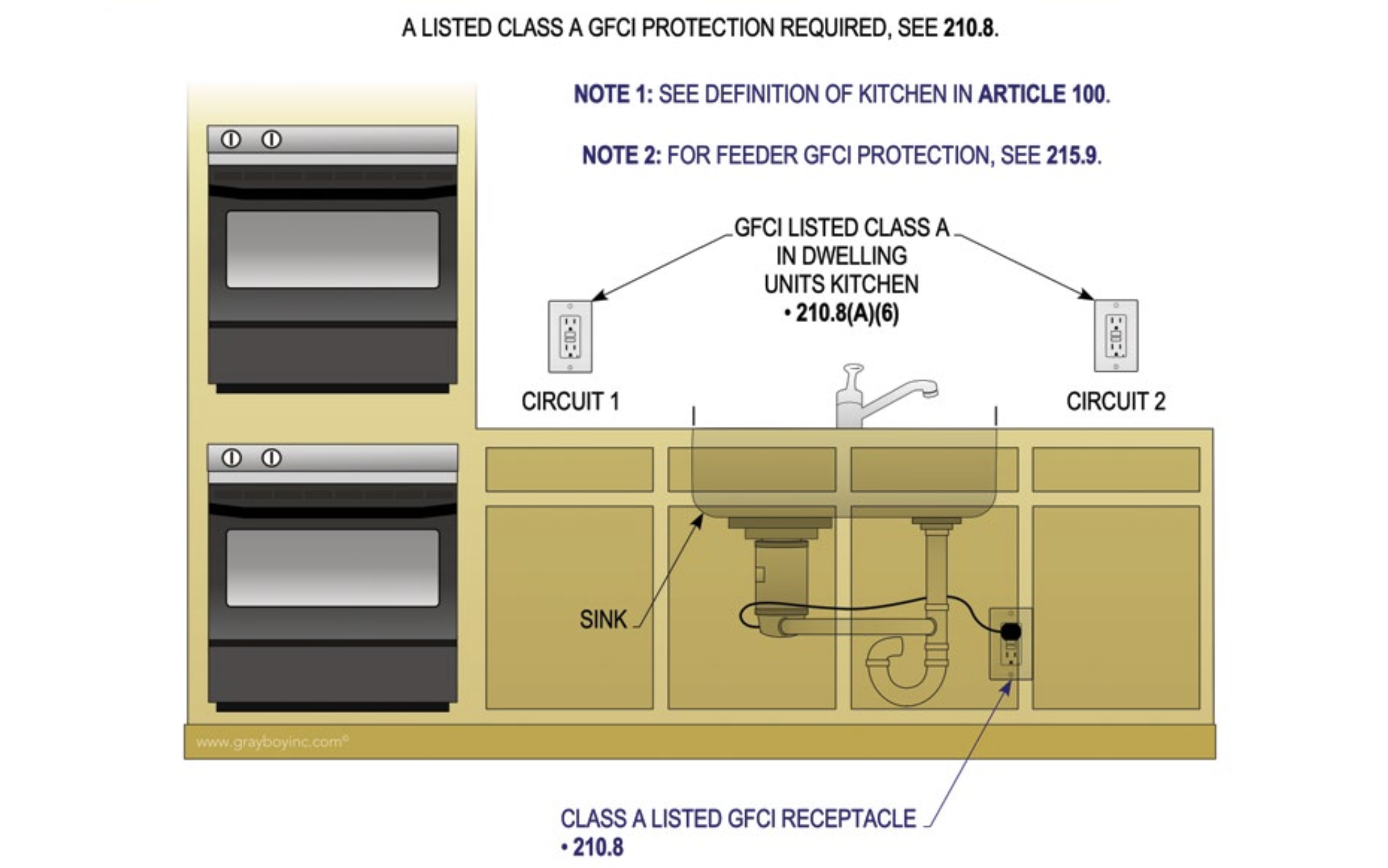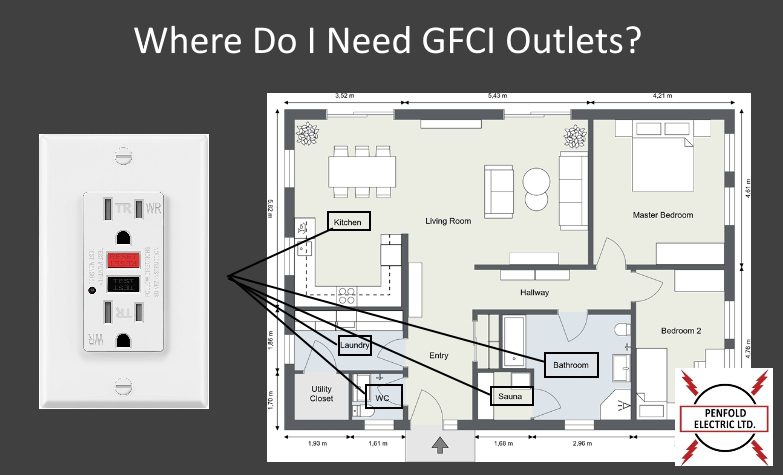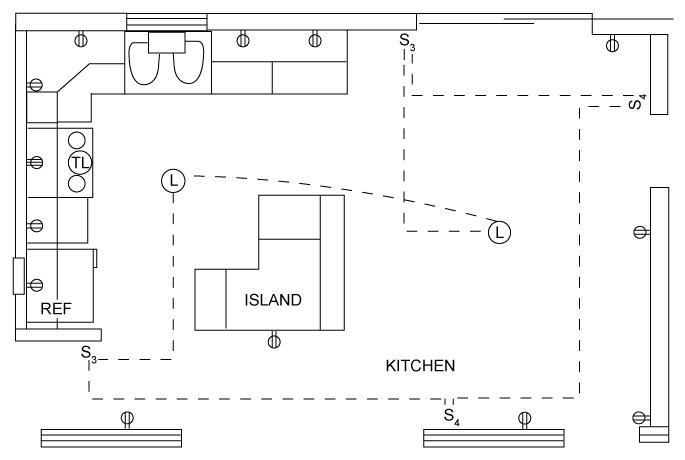Have you ever wondered about the safety standards in your kitchen? You might have heard about GFCI outlets and their importance, but do all your kitchen outlets really need them?
As you whip up your favorite meals, the last thing you want is an unsafe electrical environment. Understanding whether every outlet in your kitchen should be GFCI-protected isn’t just a technical detail—it’s a crucial step towards ensuring your family’s safety and peace of mind.
Imagine reaching for your blender or coffee maker, knowing that every outlet is safeguarded against electrical hazards. This isn’t just about compliance; it’s about creating a secure haven where you can cook and entertain without worry. Let’s dive into the specifics and unravel the mystery behind GFCI outlets, so you can take charge of your kitchen’s safety with confidence.
Gfci Basics
Understanding the basics of Ground Fault Circuit Interrupters (GFCI) is crucial when considering kitchen safety. These devices are designed to protect you from electrical shock by interrupting the flow of electricity when a fault is detected. In a space like your kitchen, where water and electricity often meet, GFCIs play a vital role in ensuring your safety.
What Is A Gfci?
A GFCI is a specialized outlet that monitors the electrical current flowing through it. If it detects even a slight imbalance, it shuts off the power instantly. This rapid response can prevent serious injuries or even fatalities.
Think of it as a vigilant guardian keeping an eye on potential electrical hazards. You might have noticed these outlets with “test” and “reset” buttons in your home. They’re not just there for show; they serve a critical purpose.
How Does A Gfci Work?
Imagine you’re washing dishes, and water splashes onto the toaster plugged in nearby. A GFCI senses the change in electrical flow and cuts off power to prevent shock. It’s like having a safety net that leaps into action before you even realize there’s a danger.
GFCIs constantly monitor the current and act within milliseconds. This quick action can mean the difference between a minor inconvenience and a severe accident.
Where Are Gfcis Required?
GFCIs are mandatory in areas where water and electricity could mix, such as kitchens, bathrooms, and outdoor outlets. The National Electrical Code (NEC) specifies these requirements to enhance safety in everyday environments.
Consider your kitchen layout. Are all outlets near the sink or appliances GFCI protected? If not, it might be time to reassess your setup to align with safety standards.
Why Your Kitchen Needs Gfcis
In the hustle and bustle of daily cooking, you might not think twice about the outlets around you. Yet, these unnoticed components are critical for your safety. A simple spill or accidental contact can lead to dangerous situations without proper protection.
Reflect on your kitchen habits. Have you ever plugged in an appliance with wet hands? The presence of GFCIs ensures that these everyday actions don’t turn risky.
So, do all kitchen outlets need to be GFCI? While not every single outlet may require it, prioritizing those near water sources and major appliances is a smart move. How are your outlets positioned? Are they ready to protect you when you need it most?

Credit: captaincode2023.leviton.com
Purpose Of Gfci In Kitchens
The kitchen is the heart of your home, bustling with activity and creativity. But amidst the culinary adventures, safety should never be an afterthought. Ground Fault Circuit Interrupters (GFCIs) play a vital role in ensuring electrical safety in kitchens. These devices protect you from electrical shocks, which can occur when your body becomes a path for electricity to the ground. Understanding the purpose of GFCI in your kitchen can help you maintain a safe cooking environment.
Understanding Gfci Functionality
GFCIs are designed to detect imbalances in electrical current. If electricity flows through an unintended path, such as water or a person, the GFCI quickly shuts off the power. This rapid response prevents shocks that could potentially be life-threatening.
Imagine you’re washing dishes and water splashes onto an outlet. Without a GFCI, this could lead to a dangerous shock. With a GFCI, the risk is minimized. It’s a small device with big protective power.
Why Kitchens Need Gfci
Kitchens are wet environments where water and electricity frequently meet. Whether you’re rinsing veggies, washing dishes, or boiling pasta, water is everywhere. This increases the risk of electrical shock.
GFCIs are crucial in kitchens because they safeguard you in these wet conditions. They ensure that your cooking adventures remain safe, even when the sink splashes.
Personal Experience: A Lesson Learned
Once, I was blending a smoothie when the cord touched a small puddle on the counter. Suddenly, the blender stopped. My heart raced as I realized the GFCI had tripped, protecting me from potential harm. This experience underscored the importance of GFCIs in keeping you safe.
Considerations For Gfci Placement
Not all outlets need to be GFCI, but strategic placement is key. Focus on areas near sinks, counters, and cooking appliances. These spots are more likely to encounter water.
Think about your kitchen layout. Where do you often use appliances? Do you have outlets near the sink? Placing GFCIs in these areas enhances safety.
Keeping Your Kitchen Safe
Safety doesn’t stop at installation. Regularly test your GFCIs to ensure they work correctly. Press the “Test” button and see if the power cuts. If not, it’s time for a replacement.
Maintaining your GFCI outlets is as crucial as having them. It’s about ensuring continued protection for you and your family.
How do you prioritize safety in your kitchen? Are there areas where you could improve electrical safety with GFCIs?
Electrical Safety Standards
Electrical safety in the kitchen is crucial. Ensuring safety can prevent accidents. The right outlets play a key role. Kitchen outlets must be safe and efficient. Understanding the standards helps maintain a secure environment.
Understanding Gfci Outlets
GFCI stands for Ground Fault Circuit Interrupter. These outlets protect from electric shocks. They detect imbalances in electrical currents. When detected, they cut the power. This reduces the risk of shock or fire.
Why Gfci Outlets Are Important
Water and electricity are a dangerous mix. Kitchens often have both. GFCI outlets are vital in wet areas. They prevent potential hazards. Safety becomes more manageable with these outlets.
Locations Requiring Gfci Outlets
Kitchens are not the only places needing GFCI outlets. Bathrooms and garages also require them. Any area near water should have GFCI protection. This ensures overall home safety.
Compliance With Electrical Codes
Electrical codes mandate GFCI use. Staying compliant with these codes is essential. Non-compliance can lead to fines or accidents. Regularly check and update your outlets. Safety should always be a priority.
Benefits Of Using Gfci Outlets
GFCI outlets provide peace of mind. They offer protection against shock. They also prevent electrical fires. Ensuring the safety of your home and family is invaluable.
Situations Requiring Gfci
Understanding when to install GFCI outlets in the kitchen is crucial. These outlets protect against electrical shock, enhancing safety. Specific situations call for their use. Let’s explore these scenarios.
Proximity To Water Sources
GFCI outlets are vital near water. Water increases the risk of electrical accidents. Areas like sinks need special attention. Installing GFCI outlets here prevents shock. They cut power instantly if they detect irregular currents. This ensures safety.
High-risk Kitchen Areas
Certain kitchen spots pose more risks. Countertops with appliances are one example. Mixers and toasters require electricity. These areas benefit from GFCI outlets. They safeguard against faults. Protecting these zones is essential for safety.
Exemptions And Exceptions
Understanding the need for GFCI outlets in kitchens is essential for safety. Yet, not all kitchen outlets require them. There are exemptions and exceptions. These depend on specific circumstances and locations. Knowing these can help homeowners and renovators make informed decisions.
Specific Outlet Locations
Some kitchen outlets are far from water sources. They might not need GFCI protection. This includes outlets for refrigerators or other large appliances. As long as they’re away from sinks or water, they could be exempt.
Older Homes And Buildings
Older homes may not have GFCI outlets installed. In these cases, updates are recommended but not required. It’s important to check local codes. Some regions might have different requirements for older buildings.
Specialized Equipment And Appliances
Certain appliances might not need a GFCI outlet. Large, stationary appliances sometimes use different safety measures. Check the manufacturer’s guidelines. They provide specific safety instructions for these appliances.
Local Building Codes
Local codes can vary. It’s crucial to consult them. What applies in one area might not in another. Always verify the local regulations for your kitchen. This ensures compliance and safety.
Qualified Electrician Advice
Consulting a qualified electrician can clarify exemptions. They understand the specifics of electrical codes. Their expertise can guide decisions about GFCI requirements. This ensures both safety and compliance.

Credit: penfoldelectric.com
Installation Considerations
Installing GFCI outlets in the kitchen involves several considerations. These include deciding whether to do it yourself or hire a professional. Also, understanding the cost implications is crucial. Proper installation ensures safety and compliance with electrical codes.
Diy Vs. Professional Installation
Installing GFCI outlets can be a DIY task for some. It requires basic electrical skills. Confidence in handling electrical wires is important. Mistakes can lead to serious risks. Hiring a professional electrician ensures correct installation. It eliminates any safety concerns. Professionals have the expertise to handle complexities. They follow local electrical codes and standards. This ensures peace of mind and safety.
Cost Implications
DIY installation might save on labor costs. Yet, it can lead to errors that need fixing later. This might increase overall expenses. Professional installation may seem costly upfront. But it guarantees safety and compliance. Electricians charge for labor, materials, and expertise. The cost varies based on location and complexity. Investing in professional services ensures long-term safety. It can prevent expensive future repairs.
Troubleshooting Gfci Issues
Kitchen outlets often require GFCI protection to prevent electrical shocks. GFCI outlets are crucial near sinks and cooking areas where water is present. Understanding these requirements can help maintain safety in your kitchen space.
Troubleshooting GFCI Issues can be quite a task, especially when you’re in the middle of cooking your favorite meal. Imagine preparing dinner, and suddenly, the blender stops working because the outlet tripped. Frustrating, right? Understanding how to deal with these issues can save you time and prevent unnecessary stress. Let’s dive into some common problems and simple solutions that can make your kitchen experience smoother.Common Problems
GFCI outlets are designed to protect you, but they can sometimes be a bit sensitive. One common issue is frequent tripping. This might happen due to moisture in the kitchen or faulty appliances. Another problem is the outlet not resetting. You might press the reset button, and nothing happens. This can be due to wiring issues or a malfunctioning GFCI unit. These problems can disrupt your kitchen routine. So, it’s essential to identify the cause quickly and fix it.Resetting And Testing
Resetting a GFCI outlet is often the first step in troubleshooting. Simply press the reset button on the outlet to restore power. If the outlet doesn’t reset, check for any visible signs of damage or water exposure. Testing your GFCI outlet is crucial to ensure it’s working correctly. Use a GFCI tester to check the outlet. Plug it in and press the test button to see if it trips. If it doesn’t, there might be a problem with the outlet itself. Regular testing can prevent bigger issues down the line. Is your outlet tripping too often? Maybe it’s time to investigate further. Don’t let GFCI issues keep you from enjoying your kitchen space. Understanding these common problems and knowing how to reset and test can make your culinary adventures stress-free. Remember, a little troubleshooting can go a long way in maintaining a safe and efficient kitchen.
Credit: www.chegg.com
Future Trends In Kitchen Safety
GFCI outlets are crucial for kitchen safety. They prevent electrical shocks by shutting off power during faults. As technology advances, more kitchens will likely require GFCI outlets for enhanced protection.
Future Trends in Kitchen Safety As technology advances, kitchen safety evolves alongside it. The kitchens of tomorrow will be smarter, more efficient, and safer. With innovations on the horizon, are you prepared to embrace these changes in your home?Smart Appliances And Safety Integration
Smart appliances are becoming a staple in modern kitchens. These devices not only make cooking easier but also enhance safety. Imagine an oven that alerts you on your smartphone if it’s left on or a refrigerator that monitors its own temperature to prevent food spoilage. Many homeowners already enjoy smart smoke detectors that sync with home systems. These detectors can alert you to smoke or carbon monoxide levels even when you’re away. As these technologies advance, they will become more affordable and widespread.Enhanced Gfci Technology
Ground Fault Circuit Interrupters (GFCIs) are crucial for kitchen safety. Future trends suggest these outlets will become even more sophisticated. They might include built-in sensors that detect moisture levels, shutting off power before water can cause harm. Imagine outlets that communicate with your home system. They could alert you when an appliance is malfunctioning, providing an extra layer of safety. With these advancements, GFCIs will continue to play a vital role in preventing electrical hazards.Voice-activated Safety Features
Voice-activated technology is not just for convenience. In the future, it will be integral to kitchen safety. You could control appliances with simple voice commands, reducing the risk of accidents. Think about adjusting the stove temperature or setting timers without using your hands. This hands-free approach not only keeps your kitchen cleaner but also safer. Especially when dealing with hot surfaces or sharp tools.Energy Efficiency And Safety
Energy-efficient appliances are not only eco-friendly but also safer. They often have advanced safety features built-in. For instance, induction cooktops that heat only the cookware and not the surface itself. As energy efficiency becomes a priority, manufacturers will continue to develop safer appliances. Are you ready to upgrade your kitchen to save both energy and enhance safety?Personal Experience: A Lesson In Safety
A few years ago, I installed a smart smoke detector in my kitchen. One night, while out for dinner, I received an alert about smoke detected at home. Rushing back, I found a pan left on the stove that could have caused a fire. This experience taught me the value of integrating technology for safety. It’s not just about convenience; it’s about peace of mind. Are you considering similar upgrades for your kitchen? Future trends in kitchen safety are not just about new gadgets. They’re about creating a safer, more efficient environment for you and your family. As these innovations become mainstream, how will you adapt to keep your kitchen safe?Frequently Asked Questions
What Is A Gfci Outlet?
A GFCI outlet protects against electrical shocks. It shuts off the power if it detects a ground fault.
Do All Kitchen Outlets Require Gfci Protection?
Yes, for safety. GFCI outlets are required in kitchens to prevent electrical shocks near water sources.
How Do Gfci Outlets Increase Kitchen Safety?
They cut off power quickly during electrical faults. This reduces the risk of shocks in wet areas.
Can I Replace A Regular Outlet With A Gfci?
Yes, you can. It’s a simple upgrade for better safety. Hire a professional electrician if unsure.
How Often Should Gfci Outlets Be Tested?
Test them monthly. This ensures they work properly and provide the needed protection against shocks.
Conclusion
GFCI outlets boost kitchen safety and prevent electric shocks. Not all kitchen outlets need GFCI protection. Placement depends on proximity to water sources. Wet areas like sinks and countertops benefit from GFCI. Consult local building codes for specifics. Safety should always be a priority.
Install GFCI where it’s most needed. Regular checks ensure proper function. Faulty outlets pose risks. Protect your family with smart choices. Keep kitchen outlets updated. Stay safe and informed. Better safe than sorry. Your kitchen deserves reliable protection. Choose wisely for a safer home environment.
